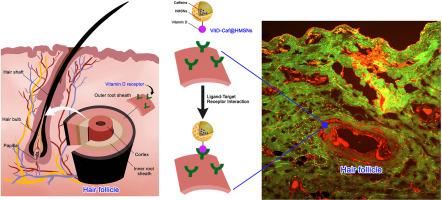胆钙化醇移植的中空介孔二氧化硅纳米颗粒用于脱发治疗中靶向和持续的咖啡因递送
IF 4.9
3区 医学
Q1 PHARMACOLOGY & PHARMACY
Journal of Drug Delivery Science and Technology
Pub Date : 2025-09-11
DOI:10.1016/j.jddst.2025.107518
引用次数: 0
摘要
脱发是一种常见且令人痛苦的状况,其特征是逐渐脱发和毛囊损伤。虽然非那雄胺和米诺地尔(MNX)仍然是脱发的标准治疗方法,但它们对全身的不良影响促使人们需要更安全的替代品。咖啡因是一种天然的兴奋剂,具有促进头发生长的特性,但它的亲水性和毛囊潴留能力有限。为了解决这些限制,我们开发了空心介孔二氧化硅纳米颗粒(HMSNs)接枝胆钙化醇(VitD-HMSNs),以改善钙的靶向递送和持续释放。胆骨化醇的高亲脂性增强了毛囊渗透,其抗氧化和抗炎作用可能与咖啡因协同作用,促进局部头发再生,同时减少全身暴露。通过溶胶-凝胶法和模板辅助法合成HMSNs,然后进行选择性蚀刻。该纳米颗粒表现出适合经皮递送的物理化学性质,包括平均粒径为~ 150 nm,孔径为2.8 nm,比表面积为1095 m2/g。傅里叶变换红外光谱(FT-IR)证实了成功的胆钙化醇接枝。咖啡因被有效负载(包封率,32.11%;负载容量,24.31%),并且与未接枝的HMSNs相比,接枝胆钙化醇(VitD-Caf@HMSNs)的载咖啡因中空介孔二氧化硅纳米颗粒的体外释放更持久。Franz扩散研究显示VitD-Caf@HMSNs (476.63 μg/cm2)增强皮肤渗透。共聚焦激光扫描显微镜(CLSM)成像证实了更深的纳米颗粒穿透-高达280 μm进入猪皮肤-并在毛囊周围积聚,支持系统的靶向潜力。在人毛囊真皮乳头细胞(HFDPCs)中,MTT实验证实了VitD-Caf@HMSNs的生物相容性。在双氢睾酮(DHT)刺激的细胞中,VitD-Caf@HMSNs显著降低活性氧(ROS),达到与MNX相当的抗氧化活性。总之,这些发现表明VitD-Caf@HMSNs是一种受体靶向的、生物相容性的纳米载体,可以持续、局部地为脱发治疗提供咖啡因,可能为传统治疗提供一种微创替代方案。本文章由计算机程序翻译,如有差异,请以英文原文为准。

Cholecalciferol-grafted hollow mesoporous silica nanoparticles for targeted and sustained caffeine delivery in alopecia therapy
Alopecia is a common and often distressing condition marked by progressive hair loss and follicular damage. While finasteride and minoxidil (MNX) remain standard treatments for alopecia, their adverse systemic effects drive the need for safer alternatives. Caffeine (Caf), a natural stimulant with hair growth–promoting properties, is limited by its hydrophilicity and poor follicular retention. To address these limitations, we developed hollow mesoporous silica nanoparticles (HMSNs) grafted with cholecalciferol (VitD-HMSNs) to improve targeted delivery and sustained release of Caf. The high lipophilicity of cholecalciferol enhances follicular permeation, and its antioxidant and anti-inflammatory effects may act synergistically with Caf to promote localized hair-regrowth while reducing systemic exposure. HMSNs were synthesized via Sol-Gel and Template-Assisted methods, followed by selective etching. The nanoparticles showed suitable physicochemical properties for transdermal delivery, including an average particle size of ∼150 nm, a pore size of 2.8 nm, and a specific surface area of 1095 m2/g. Fourier-transform infrared (FT-IR) spectroscopy confirmed successful cholecalciferol grafting. Caf was efficiently loaded (% encapsulation efficiency, 32.11 %; % loading capacity, 24.31 %), and in vitro release demonstrated a more sustained profile for caffeine-loaded hollow mesoporous silica nanoparticles grafted with cholecalciferol (VitD-Caf@HMSNs) than for ungrafted HMSNs. Franz diffusion studies showed enhanced skin permeation with VitD-Caf@HMSNs (476.63 μg/cm2). Confocal laser scanning microscopy (CLSM) imaging confirmed deeper nanoparticle penetration—up to 280 μm into porcine skin—along with accumulation around hair follicles, supporting the system's targeting potential. In human hair follicle dermal papilla cells (HFDPCs), MTT assays confirmed the biocompatibility of VitD-Caf@HMSNs. In dihydrotestosterone (DHT)-challenged cells, VitD-Caf@HMSNs markedly reduced reactive oxygen species (ROS), achieving antioxidant activity comparable to that of MNX. In summary, these findings indicate that VitD-Caf@HMSNs are a receptor-targeted, biocompatible nanocarrier that enables sustained, localized Caf delivery for alopecia therapy, potentially offering a minimally invasive alternative to conventional treatments.
求助全文
通过发布文献求助,成功后即可免费获取论文全文。
去求助
来源期刊
CiteScore
8.00
自引率
8.00%
发文量
879
审稿时长
94 days
期刊介绍:
The Journal of Drug Delivery Science and Technology is an international journal devoted to drug delivery and pharmaceutical technology. The journal covers all innovative aspects of all pharmaceutical dosage forms and the most advanced research on controlled release, bioavailability and drug absorption, nanomedicines, gene delivery, tissue engineering, etc. Hot topics, related to manufacturing processes and quality control, are also welcomed.

 求助内容:
求助内容: 应助结果提醒方式:
应助结果提醒方式:


